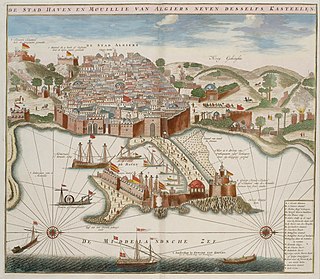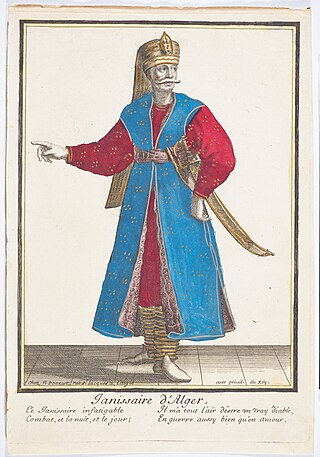
The Regency of Algiers was a largely independent tributary state of the Ottoman Empire during the early modern period, located on the Barbary Coast of North Africa from 1516 to 1830. Founded by the corsair brothers Aruj and Hayreddin Barbarossa, the Regency was a formidable pirate base infamous for its corsairs. First ruled by Ottoman viceroys, it later became a sovereign military republic that plundered and waged maritime holy war against European Christian powers.

The 2nd Bombardment of Algiers took place between 12 and 21 July 1784. A joint Spanish-Neapolitan-Maltese-Portuguese fleet commanded by the Spanish Admiral Antonio Barceló bombarded the city, which was the main base of the Barbary corsairs, with the aim of forcing them to interrupt their activities. The second bombardment followed a similarly failed expedition the preceding year.

Ali V Ben Ahmed, nicknamed Ali Khodja, Ali-Meguer, or Ali Loco was a Kouloughli of partial Georgian (Mengrelian) and Native Algerian origins born in Algeria. He was the dey of the Deylik of Algiers from September 1817, just after the assassination of his predecessor Omar Agha the 8th. He remained so until his death in February 1818. His sobriquet Ali-Meguer may indicate his Mingrelian background.

Lalla (Lella), Řalla or Řadja is an Amazigh word and title meaning "Lady", "My lady", "Miss." or "Mrs.".

The Danish–Algerian War was a conflict lasting from 1769 to 1772 between Denmark–Norway and Deylik of Algiers. which was functionally and mostly independent from the Ottoman Empire. It is also known as the Algerian Expedition, or "The War Against Algeria".

The bombardment of Algiers in 1688 was a military expedition ordered by Louis XIV against the Regency of Algiers in order to enforce the peace treaty of 1683 which had been violated by Algerian pirates. The squadron, comprising 31 ships and 10 bomb galiots, was commanded by Jean II d'Estrées.
The Battle of Chelif or Battle of Djidouia took place on 28 April 1701 on the banks of the Chelif River. It was fought between the armies of the Alaouite Sultan Ismail Ibn Sharif and those of the Regency of Algiers commanded by the Bey of Mascara, Mustapha Bouchelaghem. It took place in the context of an attempt by the Alaouites to conquer the west of the Regency of Algiers, coordinated with an offensive by Tunis on the east of the Regency of Algiers in 1700 and 1701.

The Spanish–Algerian War was a conflict between the Spanish Empire and the Deylik of Algiers.

The French-Algerian War of 1681–1688 was part of a wider campaign by France against the Barbary Pirates in the 1680s.

The Odjak of Algiers((efn|also spelled Ujaq was a unit of the Algerian army. It was a highly autonomous part of the Janissary Corps, acting completely independently from the rest of the corps, similar to the relationship between Algiers and the Sublime Porte. Led by an Agha, they also took part in the country's internal administration and politics, ruling the country for several years. They acted as a defense unit, a Praetorian Guard, and an instrument of repression until 1817.

Baba Ali Chaouch, also known as Ali Soukali, or simply Ali I, was a ruler of the Deylik of Algiers from 1710 to 1718. He was the first dey of Algiers to be invested with the title of dey-pacha. The Sultan Ahmed III had Ali Chaouch's envoy given the caftan and the three tails, a sign of the dignity of a "pasha". This title was attributed to all his successors until 1830.

The Beylik of the West was one of three Beyliks (governorates) of the Regency of Algiers, with the other two being the Beylik of Titteri and the Beylik of Constantine. It was established in 1563, and it was ended during the French conquest.
Mustapha Bouchelaghem, also known as Bey Bouchelaghem was the Bey of the Western Beylik from 1686 to 1734/37.
The siege of Oran was a battle between the Spanish Empire and the Regency of Algiers. It was started by Mustapha Bouchelaghem, the Bey of Mascara. The Algerian victory in the battle led to the city being reconquered by the Algerians for 24 years (1708–1732), before Spanish forces reconquered the town in 1732.
The siege of Oran (1693) was an attempt by the Alaouite sultan Ismail Ibn Sharif to take the city of Oran, which was then under Spanish rule. After being defeated by the Spanish, he was attacked and defeated again by the Algerian Arab tribes while retreating from the territory.
The Maghrebi war (1699–1702) was a conflict involving a Tunisian, Tripolitanian, and Moroccan coalition, and the Deylik of Algiers. It was an important milestone in the further weakening of the already fragile Ottoman grip over the Maghreb, as both sides utterly ignored the Ottoman sultan's pleas to sign a peace treaty. This war also led to the renewal of the Muradid infighting, which would later lead to the establishment of the Beylik of Tunis, and the Husainid dynasty in 1705.

The Beylik of Titteri,, was one of the three permanent Beyliks of the Regency of Algiers, the other two being the Western Beylik, and the Beylik of Constantine. It was established in 1546 and was ended during the French conquest of Algeria.

The Government Palace, known before 1962 as Gouvernement général, is the office of the Prime Minister of Algeria and a major public building in Algiers. At the time of its inauguration in 1933, with a surface of 33,000 m2, it was the largest administrative building of the entire French state.












